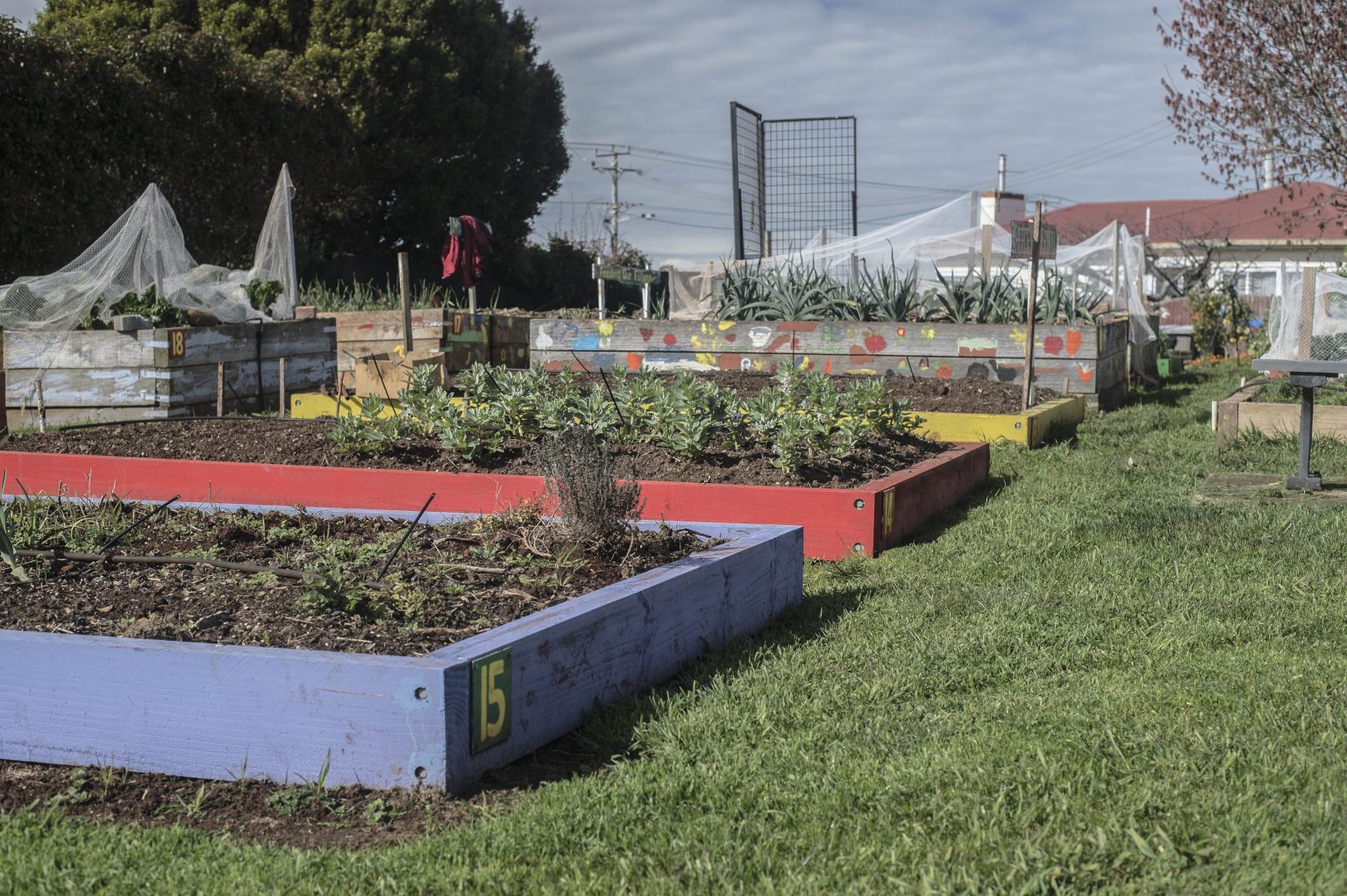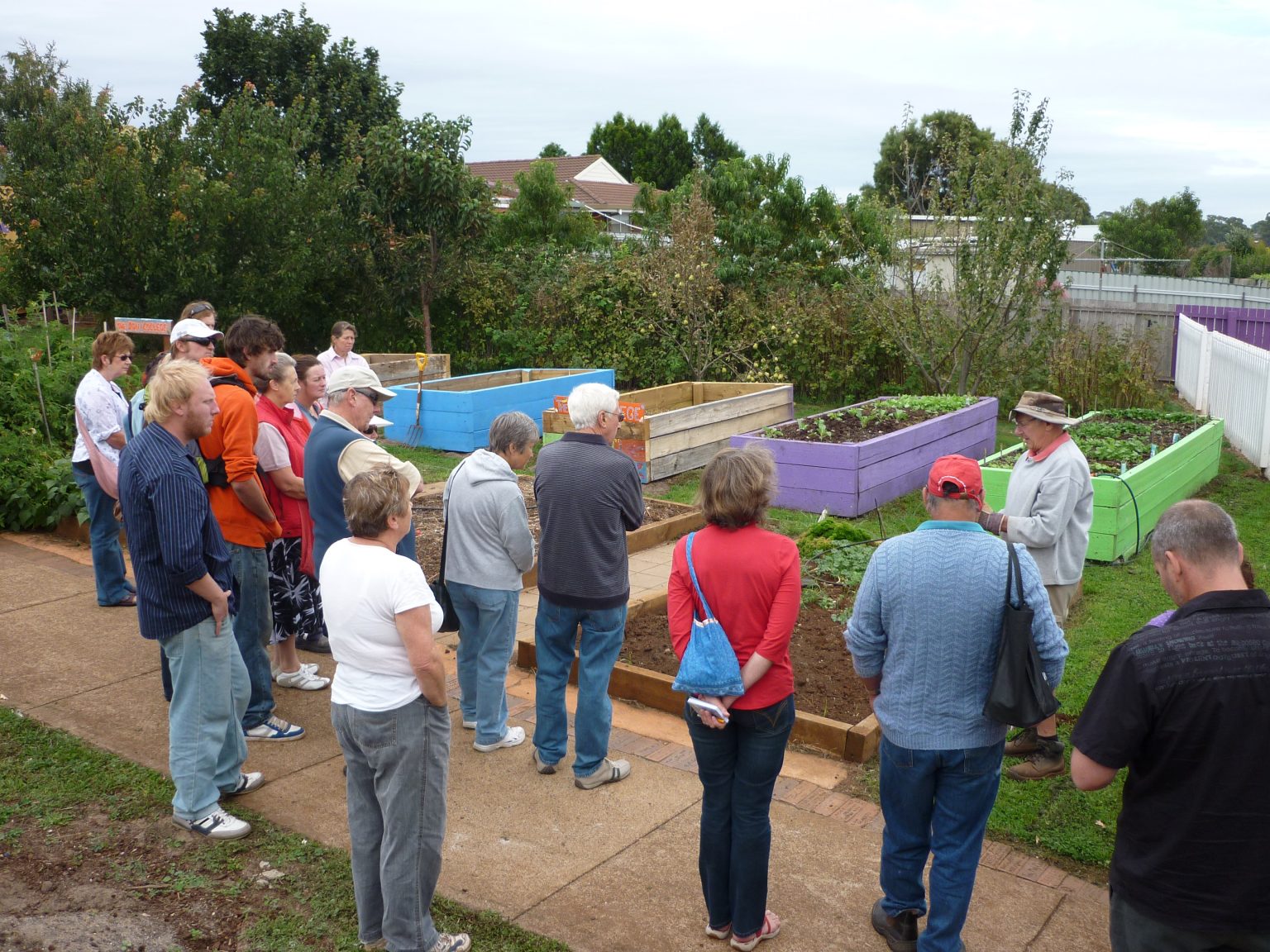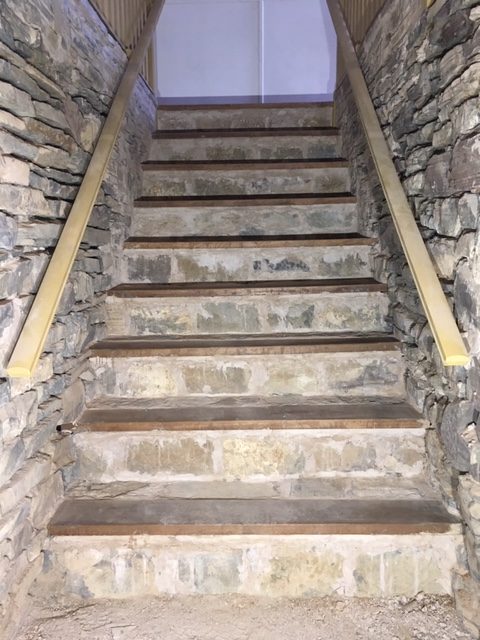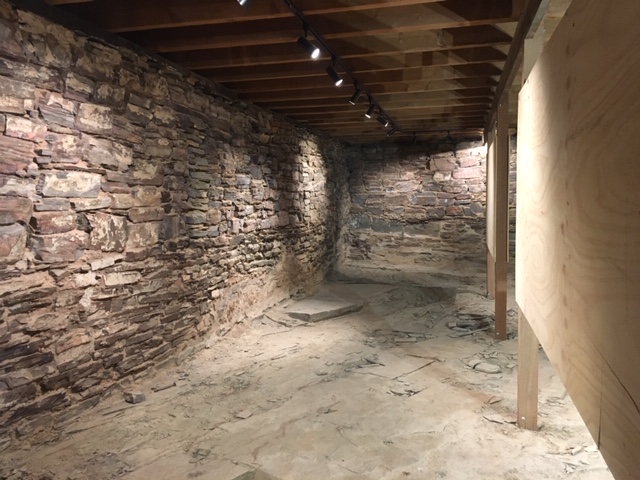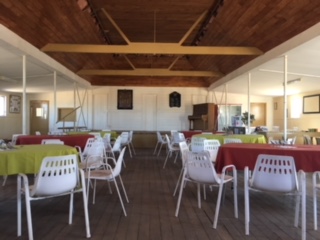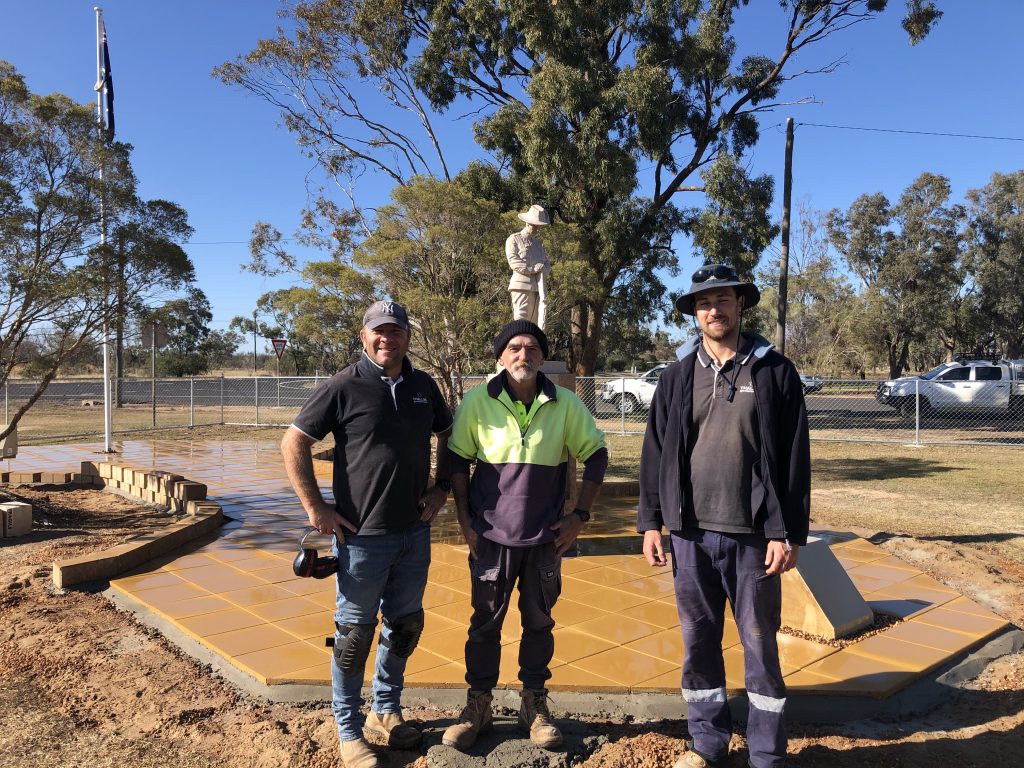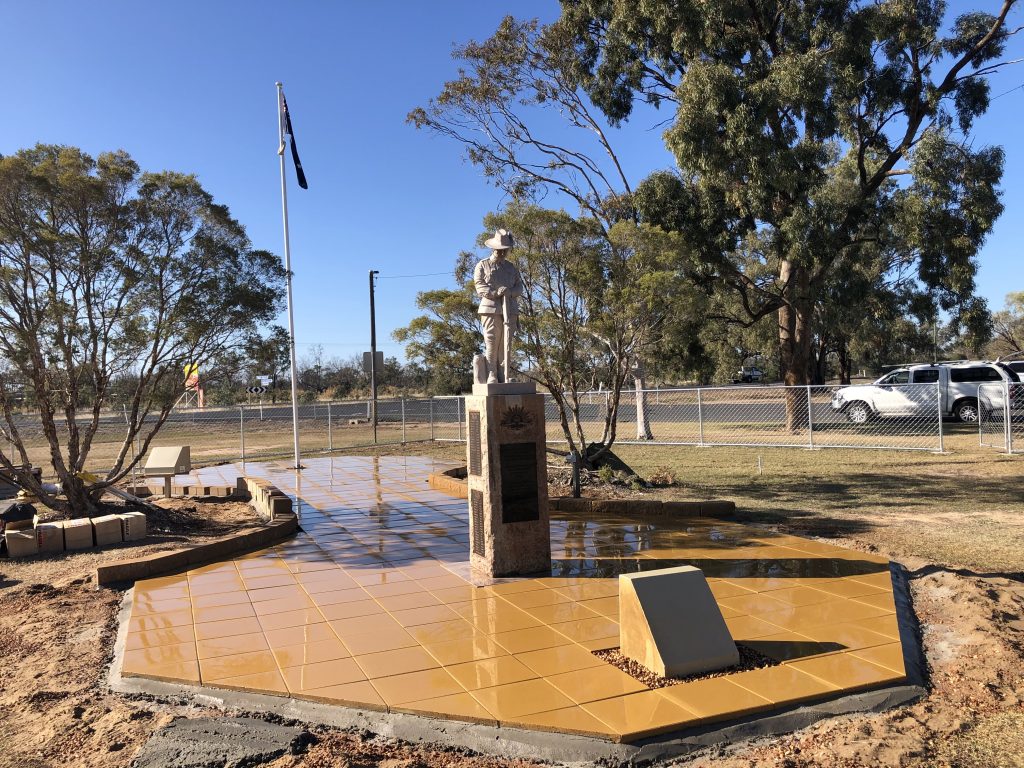Foundation for Rural & Regional Renewal (FRRR)
“The NRCF Board and staff certainly value the long-term relationship with FRRR, which is so important to us as a rural and regional Foundation. The support for NRCF’s community impact and grants team has been essential to achieve impact in the community.” Sam Henderson, CEO, NRCF
Northern Rivers Community Foundation (NRCF) was established in 2004 to connect people who care with local causes that matter, to improve community wellbeing for the Northern Rivers region of NSW. They have one of the largest footprints of any community foundation in Australia, covering from Tweed to Grafton, from the ocean all the way up past Kyogle, Woodenbong and Casino. NRCF is dedicated to improving the lives of those less fortunate in their community, either from economic circumstances, mental illness, disability, learning difficulties or drug / alcohol addiction. More recently their focus has been to support their community to navigate their disaster recovery journey following bushfires and then widespread flooding events across the region in early 2022.

NRCF has held a Fundraising Account partnership with FRRR since 2017 to attract tax-deductible donations, enabling them to help community organisations meet increasing demands on their services and work together to build resilience across the community.
Initially they raised funds through a general Community Fund, and in 2020 established the Resilience & Regeneration Fund to raise funds specifically to support disaster recovery and preparedness in their region. The Fund responds to the increasingly frequent natural disasters affecting the region and the global pandemic. Recognising that these are not isolated events, and that resilience and regeneration are integral to a sustainable and prosperous region, they wanted to attract as much money as possible.
As at 30 June 2023, NRCF has raised $1,171,600 via these two Funds. In 2022, they announced a record distribution of $327,177 to 49 recipients across the seven LGA’s of the Northern Rivers. This was supported by distributions totalling more than $162,000 from their FRRR Fundraising Account in FY22. Projects span across disadvantage, housing and homelessness, recovery and resilience, and the environment.
NRCF will also be looking to use the funds raised through the Resilience & Regeneration Fund to respond in a meaningful and impactful way to the devastation brought about by the two 2022 flooding events that occurred in quick succession through their Annual Community Grants program. Informing their response is their ongoing research project to understand the issues and conditions impacting community recovery with a view to better support local not-for-profits and their activities into the future. In May 2023 they released their second flood impact report ‘Research, Respond, Recover: A year on from disaster’ which offers valuable insights across a range of indicators about how the community is recovering. It highlights gaps in funding for medium to longer term recovery, and ongoing key issues of concern around health and wellbeing, housing and homelessness.
With this increase in support comes a need for increased resourcing. Fortunately, NRCF has also received donations via their Fundraising Account specifically to support their operational and staffing costs through their General Fund. As a result, the role of Grants and Community Impact Manager has been introduced, which will boost their capacity, enabling them to expand their community grant programs and supporting them to broaden their reach.
Sam Henderson, NRCF’s CEO, said ‘The NRCF Board and staff certainly value the long-term relationship with FRRR, which is so important to them as a rural and regional Foundation. The support for NRCF’s community impact and grants team has been essential to achieve impact in the community.’ The need to respond to disasters has now increased so much that they’ve also recruited a part-time Grants Administration Officer to support the Community Impact Manager.
Spirit of charity shines bright in a tough year to help rural communities adapt and evolve
A unique Australian charity significantly increased its year-on-year grantmaking, giving remote, rural and regional communities across the country a much-needed funding boost as they adapted to the impacts of natural disasters and COVID-19.
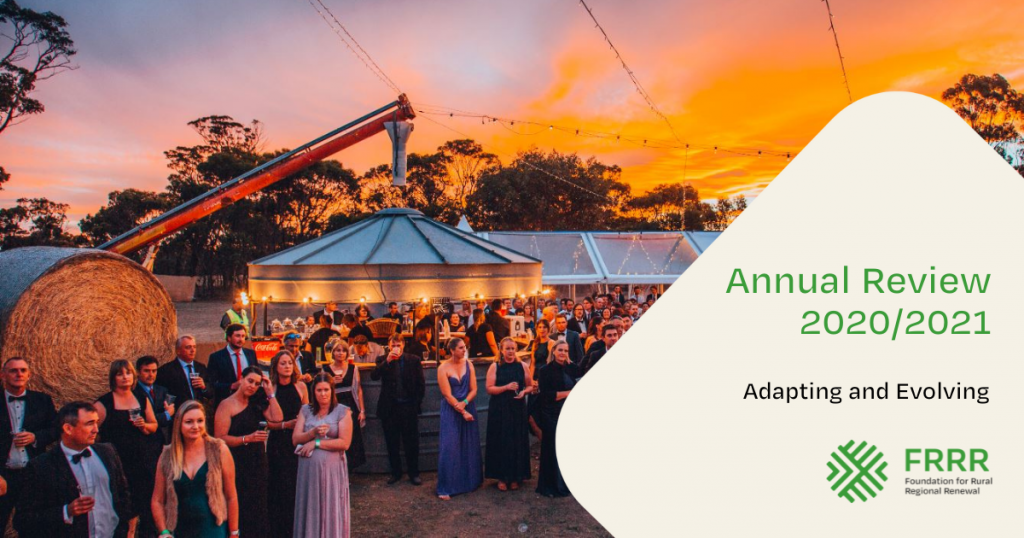
FRRR (the Foundation for Rural & Regional Renewal) supports small not-for-profit organisations across rural Australia through a mix of grant funding and capacity building activities. Their aim is to ensure local grassroots groups have the tools and support they need to implement projects that strengthen and sustain the vitality of their communities, and their organisations.
Last financial year, FRRR awarded nearly $20 million through 917 grants, an increase of around a third on the prior year. A significant portion ($4.1 million) went toward 203 recovery projects in communities impacted by the Black Summer bushfires, who were also grappling with economic and social fallout of COVID-19.
For the last 20 years, FRRR has created collaborative partnerships with Government, philanthropy, business and private funders to provide support to local organisations to fill the gaps, and address inequities in services in these areas and, critically, to strengthen community resilience.
Despite it being a tough year, everyday Australians and the philanthropic sector in particular continued to give, enabling FRRR to reach some of the smallest and most remote communities.
FRRR CEO Natalie Egleton said that while many grants to community groups are project-based, last year, in response to community needs, the organisation adapted its approach to also support more operational costs.
“The places we support are really small communities – sometimes just tens or hundreds of people – and so very few volunteers carry a lot of the load. Between the impacts of bushfires, drought, floods and COVID-19 restrictions, traditional fundraising was simply not possible. We were able to step in and support projects in more than 540 different postcodes across the country.
“With these communities being so resourceful, most projects don’t actually need all that much funding. In fact, our median grant was only around $13,000. While that figure has increased over time, we still award many grants that are just a few thousand dollars.
“It’s surprising just how big an impact can be created with relatively little, especially when people come together and given collaboratively, as they have this year,” Ms Egleton said.
“While it’s been a tough 12 months, thanks to the support of our corporate and philanthropic partners, and hundreds of individual donors, we are proud to have been able to sustain and indeed strengthen many rural communitites,” Ms Egleton concluded.
FRRR’s FY2020/21 Annual Review is available at www.frrr.org.au/AR21.
Moree is a major agricultural centre in northern New South Wales, noted for its part in the Australian cotton-growing industry. Community workshops conducted by both Moree Secondary College and Moree Plains Shire Council during their strategic planning forums found public perception of the local high school at an all-time low.

In YEAR, The newly-formed Moree Secondary College P&C Association has a committee of 12 parents, who work together to improve the facilities, equipment and uniforms for the 400 students at both the junior and senior campuses of Moree Secondary College (MSC). They developed a comprehensive communications plan designed to turn the negative perceptions around and to convey a more positive image of the school. Their aim was to showcase Moree Secondary College as an option for a quality local education, and improve the community’s relationship with the school to ultimately increase enrolments and keep more families in Moree.
A $5,000 Aussie Cotton Farmers Grow Communities grant, funded by the Monsanto Fund, helped to implement the communication plan, funding a multi-pronged campaign designed to change perceptions and raise awareness of the great things about the school, to improve engagement with the school. The campaign included a promotional video, student and teacher profiles, print and web media publications, and community engagement events. Moree Plains Council committed $3,000 to the project, and the College also contributed funding.
The P&C engaged a freelance journalist to write student and teacher profiles that were posted onto social media, as well as media releases covering various school events and articles to celebrate success in arts, sports and academic excellence.
An event was organised to launch the new video. Attended by the Executive Director and Regional Director of Education, Local Members of Parliament, Moree Plains Shire Council Mayor and more than 100 community members, the MSC P&C was able to showcase the achievements of past students. Four shorter videos were also developed to showcase Drama, Hospitality, Woodwork and Metalwork capabilities and achievements at the school.
In reporting on the project, MSC’s P&C representative Kelly James said that the 2019 year 7 and 10 intakes were at record levels. “It’s hard to know what direct benefit our promotional campaign has had on student numbers, but we believe it has had some positive impact. “The student profiles we’ve shared on social media have been excellent, with many comments often added to a post, which reinforces the dedication of the MSC teachers, the resources available and quality students graduating from Moree Secondary College.”
In the last 12 years, the beloved community garden in Devonport, Tasmania has become a hub for local residents, where they come together for a range of activities. The garden is very popular among volunteers, seniors and the elderly, schools and people with disabilities in the community. For these groups in particular, the Community Garden is a place to socialise, grow and harvest local produce and get some fresh air.
Devonport Community House (DCH) has overseen the care and maintenance of the garden and surrounding areas since 1938. When they noticed the deteriorating condition of the wooden sleepers containing each of the more than 30 garden beds, they knew it was time for an upgrade.
With a $10,909 donation by the Thyne Reid Foundation, the DCH were able to purchase “ewood” sleepers to replace the rotten wooden sleepers. The ewood sleepers are more durable and are made of recycled plastic that will ensure at least 50 years of garden bed life, making them a sustainable investment for the Community Garden.
The process of replacing the wooden sleepers took only a few weeks and has helped to give new life to the Community Garden that has already given so much to the residents of Devonport. These improvements have not only increased the longevity of the garden but have also increased food security for the 20-50 people a week who access the garden through FoodShed, a food distribution organisation that helps farmers make profit.
In the 12 years that the garden has been operational, DCH has been able to see the joy it has given many of the residents. With the long life expectancy of the ewood sleepers, the success and activity around the garden looks set to continue long into the future.
Beltana is a remote town with a permanent population of around 35 people, located 540 kilometres north of Adelaide in South Australia. The picturesque place is a state heritage listed town, with many of the original buildings still standing and in use. Despite the incredible remoteness of the community, they have approximately 50 cars pass by the town every day, and this can be up to 150 cars per day in peak tourist times.
The Beltana Progress Association begun restoration works on the local Assembly Hall to establish a local gallery and artefacts exhibit and a small café for tourists and locals alike. An underground cellar measuring 20m x 7m and 3m deep hadn’t been accessed in years but provided an opportunity to create a new historical space and also a cool gathering space in the warmer months. However, it was unsafe to enter and needed significant restoration works.
With thanks to the ANZ Seeds of Renewal Program, FRRR was able to provide the Beltana Progress Association with a $15,000 grant to contract a local carpenter to carry out the restoration works and create a new space for residents and tourists alike!
Upon gaining access to the cellar it became apparent that there was significantly more dirt and debris that initially anticipated. Residents came together and worked to remove nine tons of it, bucket by bucket. Pleasingly, the original stairs were still there, although they needed a significant restoration to be made safe.
Local tradespeople worked together to reset the original stones that were used to establish the stairwell when it was originally constructed, before creating new timber treads. Finally, a new balustrade was constructed to ensure that the stairs could be used safely.
The Beltana Progress Association also discovered that rather than a stone floor, they cellar actually has a natural sleet reef, and received advice on how to safely preserve that floor, while still allowing for the space to be operational as a gallery.
Jan Ferguson AM, who is the President of the Beltana Progress Association, said of the project; “There were 468 hours of volunteer time in the project as well as significant donations from the community. There has also been significant interest from tourists in the cellar even though it is not open to the public yet.
“The cellar has not been in use for at least 70 years. The fact that it is now a usable space and has been restored meticulously has brought a great deal of community pride. Our volunteers faced with 9 tons of rubble that had to be manually removed just stuck at it day after day in very difficult circumstances.
“We are most proud of the replacement of the original staircase which looks amazing and that as a very small community we have been able to achieve the project.
“The local tradespeople talked about it as once in a lifetime project and worked tirelessly to achieve the result in partnership with the community.”
North Star Sporting Club plays a critical role providing recreation facilities in the local community, and it’s equally important that the right first aid equipment is on hand.
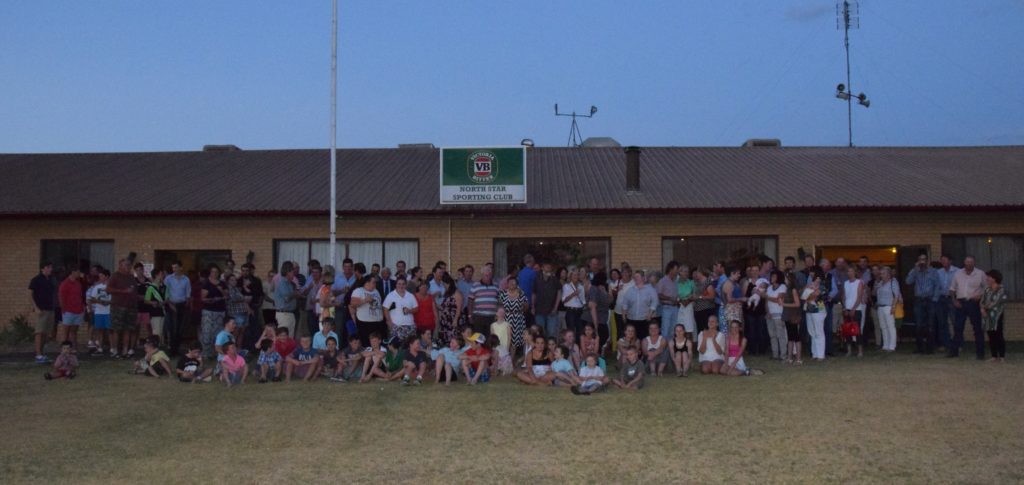
It’s why the club was nominated by a local farmer for an Australian Cotton Farmers Grow Communities (ACFGC) grant valued at $5000 and sponsored by Bayer Crop Science through the Bayer Fund. This has enabled them to purchase a defibrillator and three comprehensive first aid kits.
North Star Sporting Club President Jeffrey Nixon, who runs the property ‘Merwood’ in the district, says the club has a tennis court, runs horse events, and also hosts the North Star Trail Ride, which at one point was the biggest non-competitive dirt bike event in Australia.
“Obviously, safety’s an issue, and over the years we’ve had Westpac and RACQ helicopters in about 15 times, and that’s part of the back story of the grant application,” Jeffrey says.
“A local resident had a heart attack here in 2014 and three people did CPR until they were able to get a local St Johns Ambulance defibrillator in operation, and then the RACQ helicopter was diverted to North Star with an emergency doctor on and we were able to save his life.”
The situation sowed the seed for having a dedicated defibrillator and three substantial first aid kits at the club, with local cotton grower Naomi Mulligan successfully nominating the organisation for an Australian Cotton Farmers Grow Communities grant.
The need for the equipment was again sadly highlighted by the passing of a person at the club grounds just prior to the grant application being submitted.
“It’s very sad, and you think, if we’d have had the defibrillator here, we might’ve been able to make that a different story, but at the time we didn’t have it,” Jeffrey says.
“While COVID-19 has delayed the installation of the equipment and the associated training that needs to take place, the plans are set.
“We want the defibrillator to be accessible, so it will be on the outside of the club building in a safety box, which requires glass to be broken, and then it can be opened.”
With people coming from all over Australia, and even around the world, for events at the North Star Sporting Club, Jeffrey says they need to have the right safety equipment in place, and the ACFGC grant has played a critical role in achieving this.
“When something happens like when John had his heart attack here at the trail ride in 2014, all of a sudden you need this one piece of equipment, which is a life saver,” he explains.
“When we invite people to an event at North Star, we need to be able to give them confidence that we do our best to have first aid equipment onsite.
“We don’t want to have to be waiting for the ambulance to turn up. We want to be able to get in and get something done.”
Aside from the safety aspect, Jeffrey stresses the financial challenge is always present for small community clubs, and grants like the ACFGC program are key.
“We’ve got our power bill, our water bill, everything else to pay for, and that’s not given, we’ve got to earn enough money to do all those things, and when someone like Bayer and FRRR come along, and we can get some of those very important items onsite at the club, it makes a huge difference,” he says.
“It’s not like in the city where you’re only five minutes from the ambulance station. Out here, if you need a helicopter, it’s two hours away at the minimum.
“We’re very appreciative for the grant, that’s for sure, it makes our job a bit easier.”
In 1979, an idea was formed between a bunch of country music loving mates over a few drinks around a campfire in the south west of WA. It became the Country Music Club of Boyup Brook (CMCBB), and before long, they were putting on a show on a regular basis.
Since 1986, the Boyup Brook Country Music Festival has been a major drawcard for this small farming community, attracting more than 10,000 visitors. The CMCBB does a lot more than put musicians on a stage though – there is a strong commitment to upskilling and training it’s volunteers and trainees in all aspects of event planning, including administration, bookkeeping, budgeting, grant writing, event management and office procedures, supporting them to gain financial literacy and job readiness skills. This benefits a core group of 20 volunteers that contribute to pre-planning throughout the year, and 150 during the Festival weekend. The Festival also provides the main fundraising event for more than 36 local community groups that participate during the weekend.
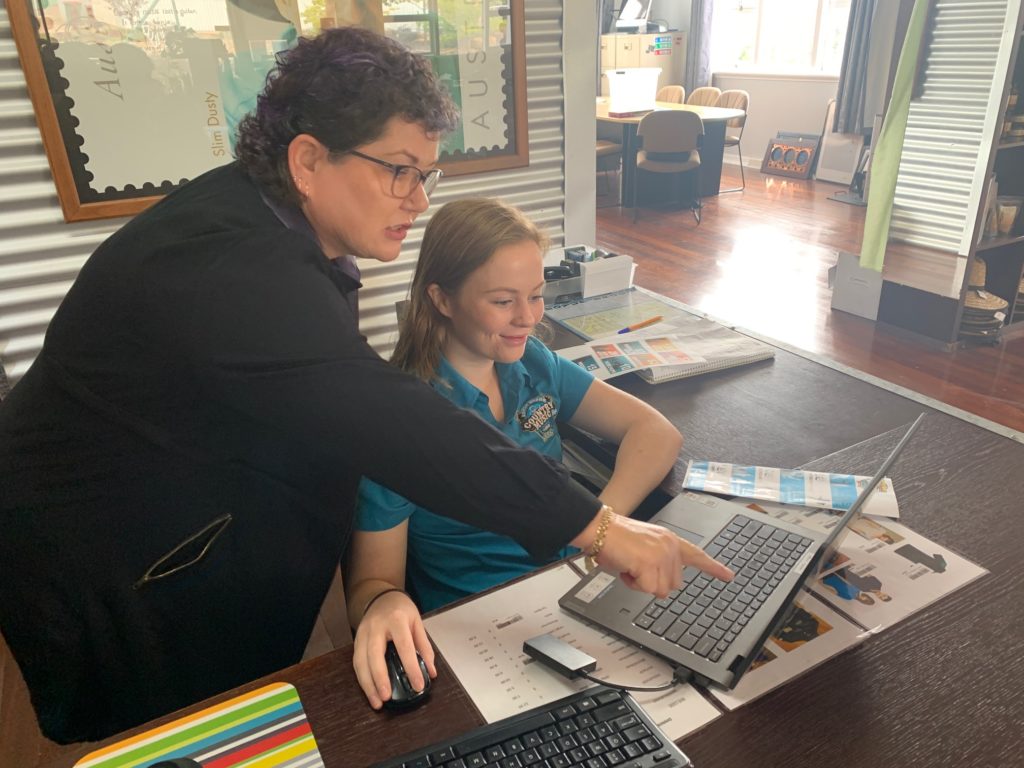
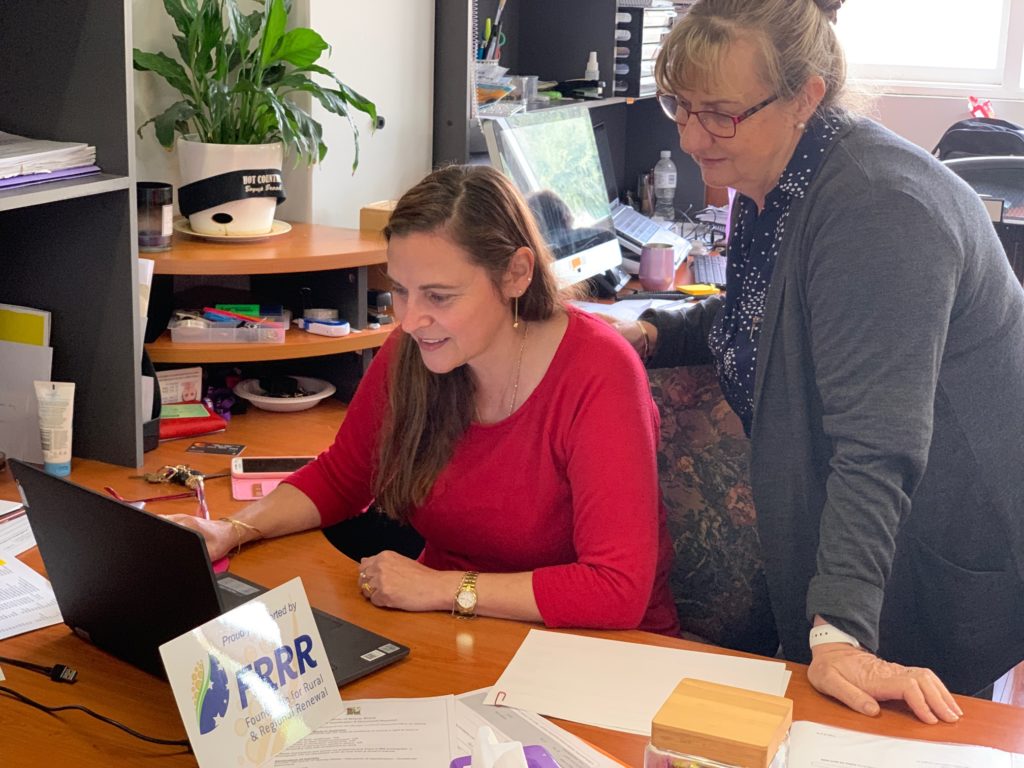
A couple of bad years recently set the club back: in 2017, flooding required the festival to be relocated; and in 2018 the club was hit by a sophisticated ticket scamming operation. On top of all this, the IT equipment available to the group was ageing and unreliable, often freezing unpredictably. Two of the computers were classed as ‘vintage’ by Apple, and the club said they could take a “very long time before they decide to boot up and one makes a noise like crickets are in the building.” This hurdle was adversely affecting the efficiencies and upskilling of the core group volunteers, not to mention the security of ticket sales and smooth running of the festival. But the tough luck the Club had run into had affected their capacity to invest in new equipment.
Daly and Sharon Winter, CMCBB’s President and Music Director, say the Festival helps a small rural community build a vibrant and sustainable community.
“It has wider audience appeal with a multiplier effect for injecting new capital into the local economy, and improves financial well-being within our community. The Festival is a celebration of our country lifestyles and community spirit. The event encourages hundreds of visitors to our state, providing a great boost to our tourism.”
Through the ANZ Seeds of Renewal program, the Club was successful in gaining new equipment. Via the Lenovo stream of the program, the Club was delivered three new Lenovo Thinkpads to support the events future operations, productivity and skill development of the group and volunteers.
The Club also plans to train staff and volunteers to scan, edit, and save photographs and documents to preserve its history as one of the oldest Incorporated Country Music Clubs in Australia and Western Australia.
Some of the volunteers use the equipment throughout the year, and under the guidance of the committee a young employee of the club recently completed her Certificate II and III in Business, plus Event Management modules. In their report, the Club wrote: “Learning new skills through the Club has led past volunteers to new employment options and keeps people living within our rural town and region.”
Nicki Jones, a volunteer, was ecstatic when the new laptops arrived, and with them, she says she achieved much more than she anticipated.
“Not only were they efficient, user friendly and supported current applications, they had a webcam and sound! This might initially sound silly, but in the big picture, this allowed me to join webinars and learn new software packages and how to use the computer to better capacity. I found one of the new software packages extremely useful and have now produced several documents with it for the Club. These documents are up to date, professional and easy to read.”
The experience and access to technology, she said, has built her self-esteem and confidence, and she has since been successful in seeking full-time employment, bringing her new skills to her position.
“I cannot thank FRRR and ANZ enough for making life so much easier.”
The Thallon Progress Association (TPA) has operated for more than 50 years. It was incorporated in 1995, and is run by a Committee of five with 20 volunteers. The TPA works closely with other local groups and has achieved many significant projects for Thallon in the last five years. In 2015, TPA began building the town’s first war memorial, and since then, the community has embraced the ANZAC Day tradition, with more than 100 people attending the dawn service each year.
It has been a whole of community effort to establish the Cenotaph in the town park and complete subsequent stages, which included WW1 and WW2 Honour Rolls, WW1 and WW2 Commemorative Pavers and also Commemorative Booklets and a WW2 Photographic Exhibition (which is now permanently displayed in the Town Library). Up-lighting of the memorial and a new flagpole have also been installed.
A $5,000 grant from the Aussie Cotton Farmers Grow Communities program, supported by the Monsanto Fund (now Bayer Fund), enabled the TPA to embark on another stage of the project to bring them closer to completing this special memorial that will ensure those who served from the Thallon district will never be forgotten.
They used the funds to pave around the war memorial to create a safe, level surface that allows all members of the Thallon community to safely participate in the annual ANZAC Day service. The paving has also created an attractive centre piece for future landscaping to occur.
While the design of the project remained the same, the planned timeline for laying the pavers blew out, as the volunteer workforce had to prioritise working on-farm, due to the drought. Instead, Ben Thallon, a professional landscaper (and one of the descendants of JF Thallon – the town’s namesake) travelled all the way from Brisbane to lend his expertise to the project. With help from a dedicated group of community volunteers it has been completed to a very high standard, ensuring safe and easy access to the memorial area..
Future stages of the Memorial will also commemorate later wars and conflicts, with plantings to complete the landscaping.
Content warning: this article deals with sensitive themes including domestic violence that might be disturbing for some audiences.
The St George branch of the Queensland Country Women’s Association (QCWA) was established in 1946 and sixteen active members work to support the community and participate in and host a range of local events.

The members embarked on an ambitious project – upgrading a small disused unit attached to their meeting room to become a low cost, short-term accommodation unit which could be used for a variety of purposes. This includes supporting victims of domestic violence, providing a place to stay for isolated parents or families of locally hospitalised children, or for families coming into town for the likes of parent / teacher interviews. While they were fundraising locally, a local cotton grower realised they could do with more support to fund the renovations and furnishings, as the unit was empty and had fallen into disrepair.
The grower nominated them, and the received an Aussie Cotton Farmers Grow Communities grant for $5,000. This enabled them to start refurbishment of the unit to convert it into a safe haven for those in need.
Paula Hetherington, President of the St George QCWA, said that it was a steep learning curve for their small group to achieve a project of this magnitude with a miniscule bank account. “Before commencing the project, we knew there was considerable funding required to achieve the outcome of having an affordable, comfortable, self-contained unit for residents of the Balonne Shire.
“The largest cost item was building renovations, which we knew when the Aussie Cotton Farmers Grow Communities grants were open. Getting the grant enabled us to provide some much needed comfort items, such as air conditioning and window blinds for our hot summer days, comfortable bedding and a table to sit at for meals.”
The QCWA St George Branch has since been raising funds for linen, utensils, crockery, cutlery et cetera through catering for local events, and have successfully raised the necessary funds to finish the broader refit project. The renovations were completed in February, and the unit is now ready to be used for its intended purpose.
Four years ago, the Bowen branch of the PCYC received an $8,000 ANZ Seeds of Renewal grant towards equipment for its Greener Futures program. More recently the town of Bowen was hit by Cyclone Debbie.
A year on from that, FRRR’s team were in Bowen running a workshop for grant-seekers and explaining what support would be available to the community to help with the ongoing recovery.
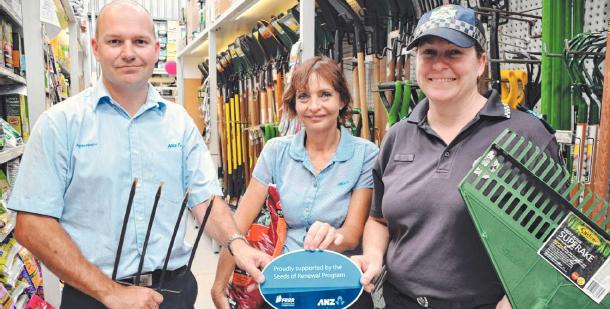
Local PCYC Branch Manager, Sergeant Michelle O’Regan made a point of coming along to the session to thank FRRR for the support the PCYC had received for the Greener Futures program.
Seed funding
PCYC Queensland’s Greener Futures program aimed to support ten students from Bowen State High School to gain hands-on experience in the horticulture industry and ultimately make them more employable.
“We take a proactive approach by giving young people leadership and building their employability skills. We tap into local resources and connect schools with businesses to build that sense of community. They say it takes a village to raise a child, so our customer is the whole community – it’s about working together and opening up opportunities for both sides to connect,” said Sergeant O’Regan.
She went on to say that seed funding was really important.
“Without that initial funding, we would have never have got the program off the ground. While the program has evolved over time, looking back [the grant] was pivotal to where we are now,” Sergeant O’Regan said.
She explained that the long-term plan for Greener Futures was two-pronged; to expand quality employment opportunities in local industries for young people facing barriers in the labour market, and to strengthen the economic vitality of the local sector through strategic support and consumer education.
Sergeant O’Regan said the initial funds were a catalyst for attracting further support and gave credibility to the initiative and what they were trying to achieve.
“The initial pilot program was a successful partnership between the high school, Stackelroth Farms, and Prospect Agriculture, with in-kind support from other local businesses and organisations that ensured the program’s success.
“That program morphed into the Resilience for life (R4L) program, which focussed on more the psychological wellbeing of our youth and attracted funds from Perpetual. From there R4L eventually became our now hugely successful WORKFit program. We received $20,000 in funds from the Queensland Government, which enabled us to employ a community development officer.
“But without the initial injection of funding from ANZ and support from FRRR, we would have struggled to get the pilot program up and running and, therefore, we would not have ended up with the program we are delivering now.
“All I know, when you build a house you need first the foundation. Five or six years later, we look back and see that those small grant funds were really pivotal to where we are now. We could never have pre-planned that.”
And she says that the benefits aren’t what you may expect.
“There are multiple layers – from small things big things can grow. For example, if we don’t have a working kitchen, we can’t hold community events or run mental health awareness programs. A bus, even, can really make a big difference to a small community.”
The role of Philanthropy
Sergeant O’Regan believes that communities need to help themselves rather than being entirely reliant on money. But it certainly helps.
“The role of philanthropy is about giving that a bit of a boost. That confidence that what they are working towards is going to be beneficial.
“It should be a hand-up, not a hand-out. Some communities are reliant on money coming in from outside, rather than working together. If you want something, you have got to work towards it. Whether it is a raffle or something else. Our young people have put in around 5,000 hours – they really want to be part of what we do.”
Sergeant O’Regan explains that people want to help, but they don’t always know how. Corporates may not have the time or the connection within the community to initiate support, but by spending time with a group, they can often work out where they can help best.
“It’s not always about money. Support can be in time and expertise. For example, I would love to be able to connect with a good business mentor, who would give up a bit of their time, so I can share my vision and ideas.
“It is about working in partnership. Come and have a look, philanthropists – see for yourselves. Let’s work together.”

